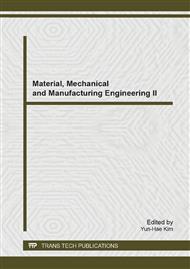[1]
Gao, J., et al., Preparation and properties of hollow glass bead filled silicone rubber foams with low thermal conductivity. Materials & Design, 2013: p.491–496.
DOI: 10.1016/j.matdes.2012.08.070
Google Scholar
[2]
Wu, X., et al., Preparation and characterization of carbon foams derived from aluminosilicate and phenolic resin. Carbon, 2011. 49(5): p.1782–1786.
DOI: 10.1016/j.carbon.2010.12.065
Google Scholar
[3]
Wu, X., et al., Effect of final pyrolysis temperature on the mechanical and thermal properties of carbon foams reinforced by aluminosilicate. Materials Science and Engineering: A, 2012: p.446–450.
DOI: 10.1016/j.msea.2012.08.025
Google Scholar
[4]
Luo, R., et al., The mechanical and thermal insulating properties of resin-derived carbon foams reinforced by K2Ti6O13 whiskers. Materials Science and Engineering: A, 2011. 528(4–5): p.2023–(2027).
DOI: 10.1016/j.msea.2010.10.106
Google Scholar
[5]
Wang, T., et al., Damping analysis of polyurethane/epoxy graft interpenetrating polymer network composites filled with short carbon fiber and micro hollow glass bead. Materials & Design, 2010. 31(8): p.3810–3815.
DOI: 10.1016/j.matdes.2010.03.029
Google Scholar
[6]
Zhou, J., et al., Thermomechanical analyses of phenolic foam reinforced with glass fiber mat. Materials & Design, 2013: p.131–135.
DOI: 10.1016/j.matdes.2013.04.030
Google Scholar
[7]
Alonso, M.V., M.L. Auad and S. Nutt, Short-fiber-reinforced epoxy foams. Composites Part A: Applied Science and Manufacturing, 2006. 37(11): p.1952–(1960).
DOI: 10.1016/j.compositesa.2005.12.011
Google Scholar
[8]
Shen, H. and S. Nutt, Mechanical characterization of short fiber reinforced phenolic foam. Composites Part A: Applied Science and Manufacturing, 2003. 34(9): p.899–906.
DOI: 10.1016/s1359-835x(03)00136-2
Google Scholar
[9]
Shen, H., A.J. Lavoie and S.R. Nutt, Enhanced peel resistance of fiber reinforced phenolic foams. Composites Part A: Applied Science and Manufacturing, 2003. 34(10): p.941–948.
DOI: 10.1016/s1359-835x(03)00210-0
Google Scholar
[10]
Feih, S., et al., Influence of water content on failure of phenolic composites in fire. Polymer Degradation and Stability, 2008. 93(2): p.376–382.
DOI: 10.1016/j.polymdegradstab.2007.11.027
Google Scholar
[11]
Gunen, Y., A. Misirli and R. Gulcan, Leaf phenolic content of pear cultivars resistant or susceptible to fire blight. Scientia Horticulturae, 2005. 105(2): p.213–221.
DOI: 10.1016/j.scienta.2005.01.014
Google Scholar
[12]
Li, J., X. Luo and X. Lin, Preparation and characterization of hollow glass microsphere reinforced poly(butylene succinate) composites. Materials & Design, 2013: p.902–909.
DOI: 10.1016/j.matdes.2012.11.054
Google Scholar
[13]
Liang, J.Z. and F.H. Li, Simulation of heat transfer in hollow-glass-bead-filled polypropylene composites by finite element method. Polymer Testing, 2007. 26(3): p.419–424.
DOI: 10.1016/j.polymertesting.2006.12.014
Google Scholar
[14]
Liang, J.Z. and F.H. Li, Measurement of thermal conductivity of hollow glass-bead-filled polypropylene composites. Polymer Testing, 2006. 25(4): p.527–531.
DOI: 10.1016/j.polymertesting.2006.02.007
Google Scholar
[15]
Swetha, C. and R. Kumar, Quasi-static uni-axial compression behaviour of hollow glass microspheres/epoxy based syntactic foams. Materials & Design, 2011. 32(8–9): p.4152–4163.
DOI: 10.1016/j.matdes.2011.04.058
Google Scholar
[16]
Gupta, N., E. Woldesenbet and P. Mensah, Compression properties of syntactic foams: effect of cenosphere radius ratio and specimen aspect ratio. Composites Part A: Applied Science and Manufacturing, 2004. 35(1): p.103–111.
DOI: 10.1016/j.compositesa.2003.08.001
Google Scholar


